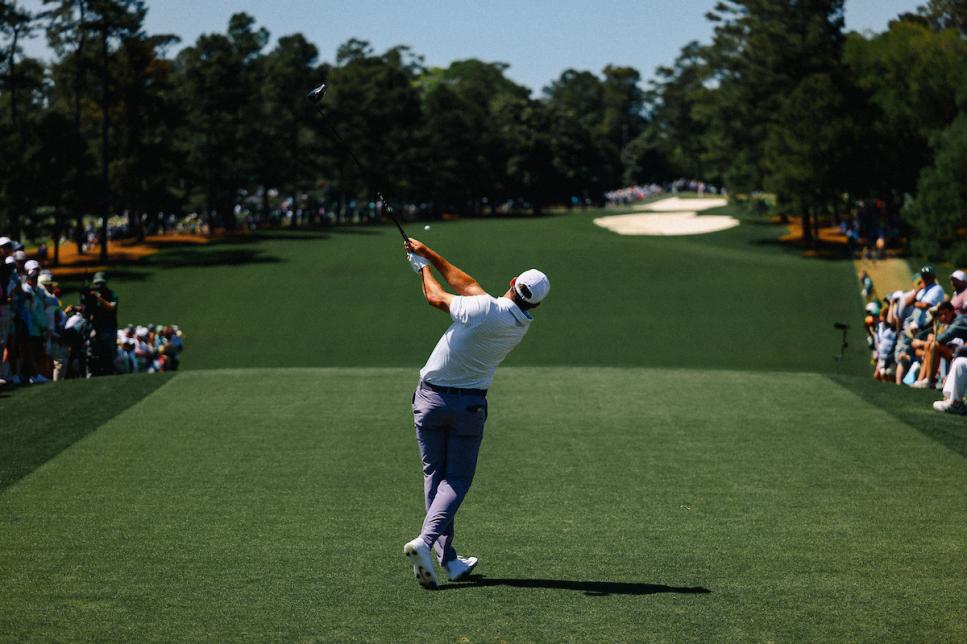AUGUSTA, Ga. — One of the wonderful things about the Masters is that it’s an event that transcends golf. People tune into the Masters who don’t watch golf on a week-in, week-out basis, which means they may be introduced to Scottie Scheffler’s golf swing for the first time. A move that has produced the best ball-striking statistics in golf the past two years.
Specifically, they’ll be introduced to the World No. 1’s unique footwork during his golf swing, and find themselves wondering: Why does he do that?
If you are one of those people, wondering that question, and finding yourself here because of it, then welcome! We’re Golf Digest, the greatest golf website in all the land, and we’ll be happy to explain …
What is ‘normal’ footwork?
Most golfers keep their feet planted firmly on the ground and in the same spot for most of their swing. Their right foot comes off the ground, but only fully by the end of their swing, and generally speaking neither foot moves around a lot.
Here’s a pretty ‘normal’ example:
What is so different about Scottie’s footwork?
Scottie Scheffler’s feet slide around quite a lot. Specifically, both feet move back behind him as he swings the club through, and also toward the target. Sometimes,
You can see an example here:
Do his feet do that every time?
Not every time, but most times. They slide around on every drive—especially when he swings hard—and most long iron shots. They start settling down on shorter shots, which makes sense because he’s not swinging as hard.
Why do his feet do that?
Every (good) golf swing has what we call in the ‘biz as a “sequence.” It’s super important.
You grip the ground with your feet and then shift your body weight first into the ground, then toward the target, then back up and around. A little like if you were to squat down then jump up and around. In oversimplified terms, that’s sort of what happens in the golf swing.
Scheffler is stronger than he is heavy. This, combined with a golf swing that moves more up-and-down than others, means he pushes back up so hard that he literally gets airborne.

Ben Walton
“He’s got long arms and an upright swing. His golf body type means he has a lot of vertical in his golf swing,” says teacher Colin McCarthy. “When people see his footwork, what they see is a reaction to something that has already happened.”
Scottie calls this a “body release,” meaning his body releases back up toward the sky as he swings the club through.
Did he ever try to change it?
Scottie Scheffler’s longtime coach is a genius teacher named Randy Smith, one of our legends of golf instruction.
Scheffler says that Smith simply didn’t think it was something he needed to change. When he tinkered around with it, Scheffler said the ball went shorter and lower, which proved his point.
What does Scheffler say about it?
Funny you should ask, here’s what he said about it earlier this week:
“When I first came out on tour, I think my footwork was kind of how I was known to people. I think a lot of people maybe viewed it as not that good of a trait in my golf swing. Some people may have said that it would be hard for me to be consistent, hard for me to play under pressure with that much action going on in my swing. But I’ve had the same coach since I was 7 years old, and he’s taught me for 20 years now how to swing a golf club. And he hadn’t wanted to change it yet, so I don’t think we’re going to change it anytime soon.”
But doesn’t it make it harder to hit the ball?
Not really, because most of the foot sliding happens after the ball is already gone. Again, it’s a reaction to something that has already happened. And again, as Scottie explained, the footwork is window dressing, which can cause people to overlook all the other fundamentally sound parts of his golf swing.
As Sceffler explains:
“Maybe the most misunderstood part of my golf swing is that people think I don’t think about my fundamentals very much, which I do. It’s a big part of my practice, and it’s usually what I do at the beginning of my practice each day is focus on my fundamentals … when my swing gets off, it’s usually something that’s very basic about what I’m doing.”
Should I do that?
Probably not, unless you can hit the ball like Scottie Scheffler.
Ok, but then what can I learn from him?
That you shouldn’t really try to make your swing look a certain way, based on how you think it should look. If Scheffler did that, he probably wouldn’t be leading the Masters right now.
A good coach can understand what the changes are that you need to make, and what you don’t. Scheffler has a good sequence, good fundamentals that allow him to deliver the clubface square, and can swing the club in a generally repeatable way.
You may not win the Masters, but you can learn those lessons from the man who has a green jacket in his closet.
This article was originally published on golfdigest.com

